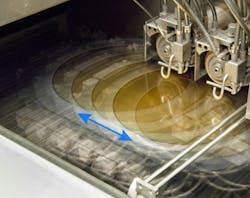CMOS sensors provide low-light images at high speed
Duisburg, Germany--Researchers at the Fraunhofer Institute for Microelectronic Circuits and Systems IMS have developed and patented a type of CMOS sensor that can use large pixels for low-light applications without suffering a reduction in speed.
Conventional CMOS image sensors are not suitable for low-light applications such as fluorescence imaging, since their large pixels arranged in a matrix do not support high readout speeds. While CMOS miniaturization is leading to increasingly smaller pixels around 1 µm across, certain applications require larger pixels in excess of 10 µm. Particularly in areas where only minimal light is available, such as in X-ray photography or in astronomy, having a larger pixel area compensates for the lack of light. Pinned photodiodes (PPDs) are used to convert the light signals into electrical pulses. These components are crucial for image processing and are built into the CMOS chips. “Yet when the pixels exceed a certain size, the PPDs have a speed problem,” says Werner Brockherde, one of the researchers. While low-light applications tend to call for high image rates, the readout speed using PPDs is too low, he notes.
The Fraunhofer researchers have developed a new component called a lateral-drift field photodetector (LDPD). “In this component, the charge carriers generated by the incident light move at high speed to the readout node,” says Brockherde. With PPDs, the electrons simply diffuse to the exit, a comparatively slow process but one that is sufficient for many applications. “But by integrating an internal electric field into the photoactive region of the component," explains Brockherde, "we have managed to accelerate this process by a factor of up to a hundred.”
To produce the new component, the researchers improved upon the currently available CMOS chip manufacturing process based on the 0.35 µm standard: “The additional LDPD component must not be allowed to impair the properties of the other components,” says Brockherde. Using simulation calculations the experts managed to meet these requirements; a prototype of the new high-speed CMOS image sensors is already available. “We expect to get approval for series production next year,” says Brockherde.
In addition to astronomy, spectroscopy, and X-ray photography, the sensors can be used as 3D sensors based on the time-of-flight process, whereby light sources emit short pulses that are reflected by the objects. The time-of-flight of the reflected light is then recorded by a sensor and used to create a fully-fledged 3D image. This technology is useful for applications such as crash protection, as the sensors can precisely record their environment in 3D. The Fraunhofer researchers have already developed this kind of area sensor based on the new pixel configuration for TriDiCam GmbH (also in Duisburg).

John Wallace | Senior Technical Editor (1998-2022)
John Wallace was with Laser Focus World for nearly 25 years, retiring in late June 2022. He obtained a bachelor's degree in mechanical engineering and physics at Rutgers University and a master's in optical engineering at the University of Rochester. Before becoming an editor, John worked as an engineer at RCA, Exxon, Eastman Kodak, and GCA Corporation.
